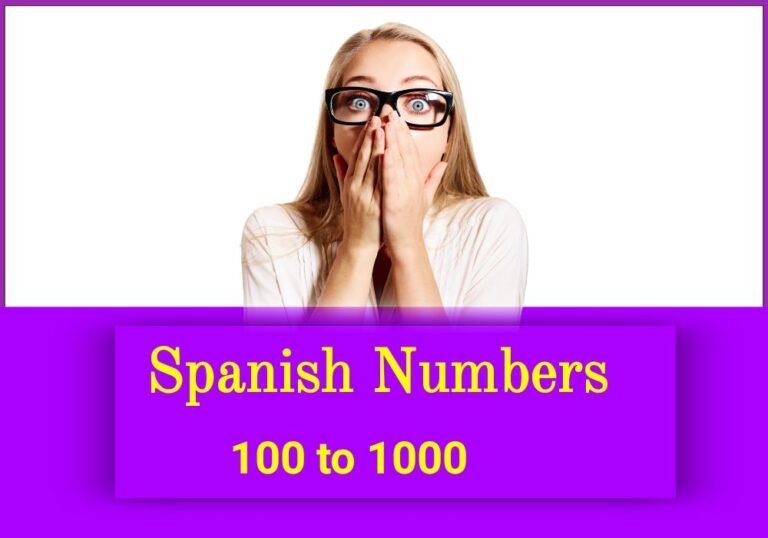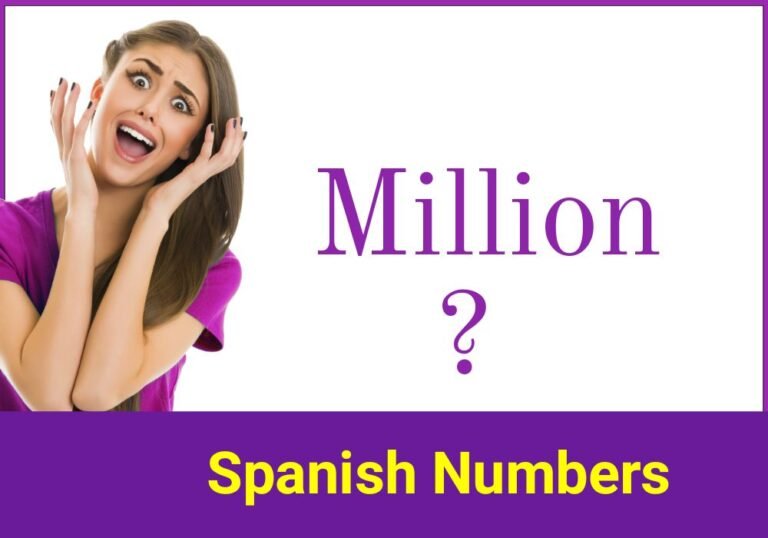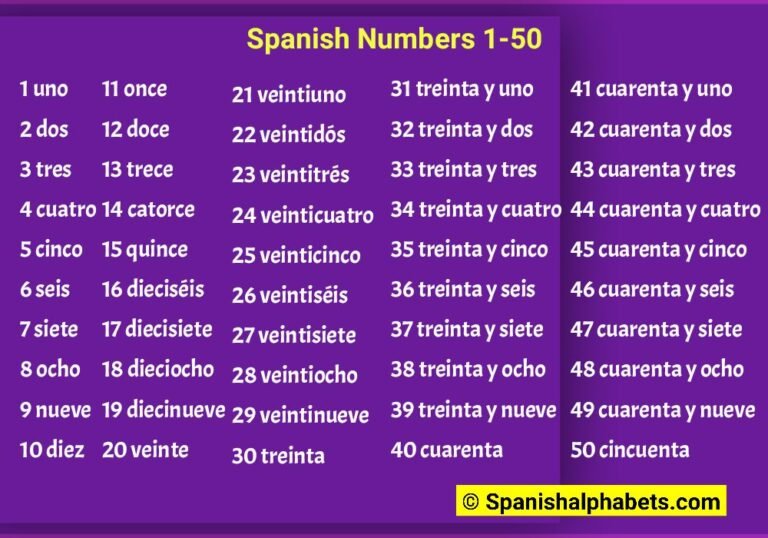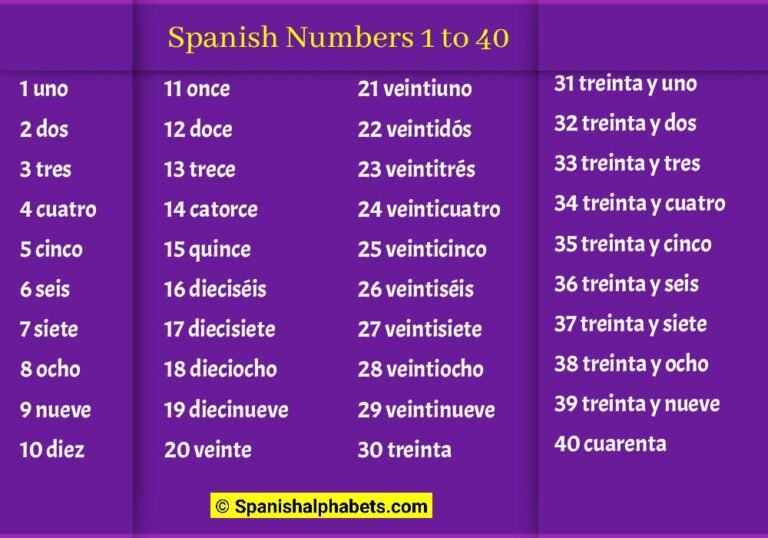Spanishalphabets.com is the best blog for learning the Spanish language. You won’t believe how easy it is to learn Spanish numbers 1-30.
This blog provides simple, step-by-step instructions that make learning Spanish fun and easy. Plus, plenty of practice exercises help you master the material.
Spanish is one of the most widely spoken languages in the world. And learning Spanish numbers 1-30 is easier than you think! With some practice, you can count to 30 in no time.
Spanish numbers 1-30 are relatively easy to learn. They can be pretty easy if you take the time to master them. Here are a few tips to help you get started:
- Start by memorizing the numbers 1-10. This is the foundation that you will build upon.
- Next, focus on learning the numbers 11-20. These follow a slightly different pattern than the first 10 numbers but are still relatively easy to learn.
- Finally, work on memorizing the numbers 21-30. These can be a little more tricky, but with some practice, you will be able to master them as well.
Pronunciation
| No. | Spanish | Pronunciation |
| 1 | uno | oo-no |
| 2 | dos | dose |
| 3 | tres | trace |
| 4 | cuatro | kwat-ro |
| 5 | cinco | sink-o |
| 6 | seis | saze |
| 7 | siete | see-yet-eh |
| 8 | ocho | och-o |
| 9 | nueve | new-eh-veh |
| 10 | diez | dee-ace |
| 11 | once | ohn-say |
| 12 | doce | dos-say |
| 13 | trece | treh-seh |
| 14 | catorce | ca-TOR-say |
| 15 | quince | KEEN-say |
| 16 | dieciséis | dee-AY-see-saze |
| 17 | diecisiete | dee-AY-see-see-AY-tay |
| 18 | dieciocho | dee-AY-see-och-o |
| 19 | diecinueve | dee-AY-see-new-EH-veh |
| 20 | veinte | Veh-een-tee |
| 21 | veintiuno | Veh-een-tee-oo-no |
| 22 | veintidós | Veh-een-tee-DOS |
| 23 | veintitrés | Veh-een-tee-TRACE |
| 24 | veinticuatro | Veh-een-tee-KWAT-ro |
| 25 | veinticinco | Veh-een-tee-SINK-o |
| 26 | veintiséis | Veh-een-tee-saze |
| 27 | veintisiete | Veh-een-tee-see-ay-tay |
| 28 | veintiocho | Veh-een-tee-OCH-o |
| 29 | veintinueve | Veh-een-tee-new-EH-veh |
| 30 | treinta | treh-een-tah |
With these tips in mind, learning Spanish numbers 1-30 doesn’t have to be complicated. In no time, you’ll be able to use them in conversation confidently!
SpanishNumbers 1-30: WOW! They Just Might be Smarter than You Think
If you think learning the Spanish numbers 1-30 is tough, think again! These seemingly simple digits tell you much about the country and its culture.
Here are eight interesting facts about Spanish numbers 1-30 that might surprise you:
- Spanish numbers 1-30 are smarter than you think. Here’s why:
- They can help you count to 30 in Spanish, of course. But did you know they can also help you with your multiplication and division?
- For example, take the number 12. In Spanish, that’s “doce.” Doce is also the product of 3 times 4 or 4 times 3. So when you’re trying to figure out what 3 times 4 is, think “doce,” and you’ll have your answer!
Make counting to 30 in Spanish a breeze!
Learning to count in Spanish is easy and fun! With some practice, you can count to 30 in no time. Here are a few tips to help you get started:
- 1 uno
- 2 dos
- 3 tres
- 4 cuatro
- 5 cinco
- 6 seis
- 7 siete
- 8 ocho
- 9 nueve
- 10 diez
- 11 once
- 12 doce
- 13 trece
- 14 catorce
- 15 quince
- 16 dieciséis
- 17 diecisiete
- 18 dieciocho
- 19 diecinueve
- 20 veinte
- 21 veintiuno
- 22 veintidós
- 23 veintitrés
- 24 veinticuatro
- 25 veinticinco
- 26 veintiséis
- 27 veintisiete
- 28 veintiocho
- 29 veintinueve
- 30 treinta.
Start by learning the numbers 1-10. Once you know these, you can start counting by 10s up to 30. For example, 10 in Spanish is diez, 20 is veinte, and 30 is treinta.
uno, dos, tres, cuatro, cinco, seis, siete, ocho, nueve, diez, once, doce, trece, catorce, quince, dieciseis, diecisiete, dieciocho, diecinueve, veinte, veintiuno, veintidós, veintitrés, veinticuatro, veinticinco, veintiséis, veintisiete, veintiocho, veintinueve, treinta.
Practice counting out loud as often as you can. This will help commit the numbers to memory. You can also try writing them down or making flashcards to help with memorization.
Finally, keep going if you make a mistake. Just keep practicing, and soon you’ll be a pro at counting in Spanish!
The following tips will make counting to 30 in Spanish a breeze:
- Practice counting out loud in Spanish regularly. This will help you get used to the rhythm and flow of the language.
- Try to find opportunities to count in Spanish in your everyday life. For example, when you’re cooking, driving, or doing laundry.
- Use a counting app or online tool to help you practice.
Mastering The Numbers 1-30 In Spanish Will Make You A Pro At Conversation!
Spanish numbers 1-30 are the key to mastering conversation in the language. By learning these numbers, you’ll be able to communicate more effectively with native speakers.
Knowing how to count in Spanish will be helpful in various everyday situations. Here’s a rundown of what you need to know about Spanish numbers 1-30.
Spanish numbers 1-30 are pretty straightforward. The first 20 numbers follow the same pattern as English, except for 13-19 (which use the ending -teen like their English counterparts).
From 21 on up, things start to get a little trickier. But don’t worry, with some practice; you’ll be able to master them in no time!
Spain’s numerical system: what makes 1 to 30 so unique?
The number 1 is considered unique in Spain because it is the first number in the numerical system. The number 2 is also considered unique because it is the second number in the numerical system.
The number 3 is also considered unique because it is the third number in the numerical system. All of these numbers have specific meanings and are used to represent different things in Spanish culture.
The number 1 represents unity and is used to represent God, while the number 2 represents duality and is used to represent evil.
The number 3 represents the Trinity and represents the Holy Trinity. The numbers 4 through 10 represent different aspects of life, while 11 and 12 represent death. 13 is a lucky number, while 14 and 15 are unlucky numbers. 16 represents good luck, while 17 and 18 represent bad luck.
Conclusion Points
In Spanish, the numbers 1-30 are all masculine. They are also all regular, meaning they follow the standard rules for spelling and pronunciation. Here are some key things to remember when using these numbers in Spanish:
To say “one” in Spanish, you use “uno.” This word is spelled exactly as it sounds. To say “two,” you use the word “dos.” Again, this word is spelled exactly as it sounds. To say “three,” you use the word “tres.” This one is slightly different, as the “r” is silent.
Remembering these simple rules will help you correctly pronounce and spell all numbers 1-30 in Spanish. With practice, you’ll be able to use them confidently in conversation!
FAQs
Spanishalphabets.com is the best place to learn Spanish numbers 1 to 30. We offer many resources and tools to help you learn, including a comprehensive FAQs section.
Our team is passionate about helping people learn Spanish and is committed to providing the best possible experience. Thanks for choosing Spanishalphabets.com!
Question (1) – How do you count from 1 to 30 in Spanish?
Answer: To count from 1 to 30 in Spanish, you need to know 1-30 in Spanish. The best way to learn these is by memorizing them, but you can also use a reference book or online resource.
You can start counting once you know the numbers 1-30 in Spanish. Start with the number 1 and say “uno” out loud. Then, count up to the number 2 and say “dos.
Question (2) – What is the number 30 in Spanish?
Answer – In Spanish, the number 30 is “treinta.” This word is derived from the Latin “triginta,” meaning “three tens.” The number 30 is a composite made up of 3 and 10. It is an even number divisible by 2, 3, 5, and 10.
Question (3) – How do you count to 19 in Spanish?
Answer – To count to 19 in Spanish, you need to know the numbers 1-19. The numbers 1-10 are uno, dos, tres, cuatro, cinco, seis, siete, ocho, nueve, and diez. The numbers 11-19 are once, doce, trece, catorce, quince, dieciseis, diecisiete, dieciocho, and diecinueve.
Question (4) – How do you count to 29 in Spanish?
Answer: To count to 29 in Spanish, you first need to know 1-10. Once you know those, you can count to 29 by adding 10 to the 20s (veintiuno, veintidós, veintitrés), or by adding 1 to the 20s (veintiuno, veintidos, veintitres).
Question (5) – How do you say 30 in Spanish?
Answer – To say 30 in Spanish, you would say “treinta.” This word is derived from the Latin word for “three,” which is “tres.” The “-nta” suffix indicates plurality in Spanish, so this word means “three tens.
Question (6) – How do you say 21 in Spanish?
Answer: In Spanish, 21 is “veintiuno” or “veinti1”. The first “veinti” is from the Latin word for 20, “viginti,” and the “uno” is from the Latin word for 1, “unus.” When saying 21 in Spanish, you would say “veintiuno” if the context is counting objects, and “veinti1” if the context is telling time.






